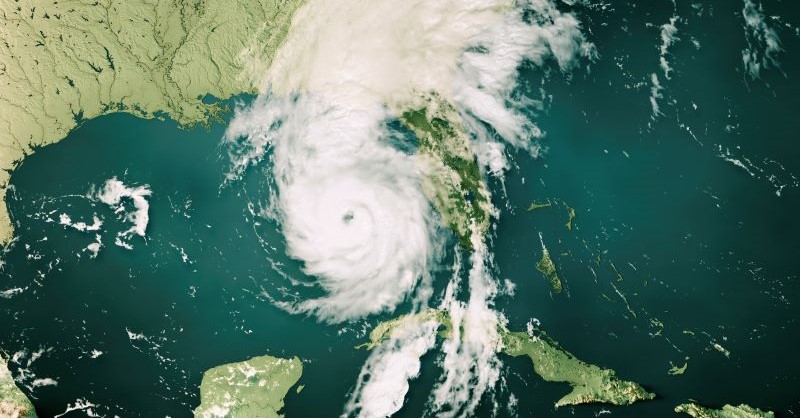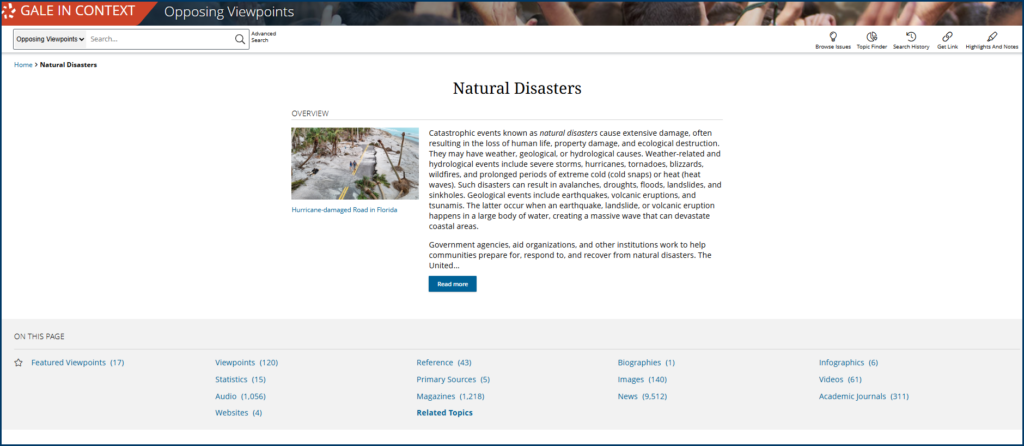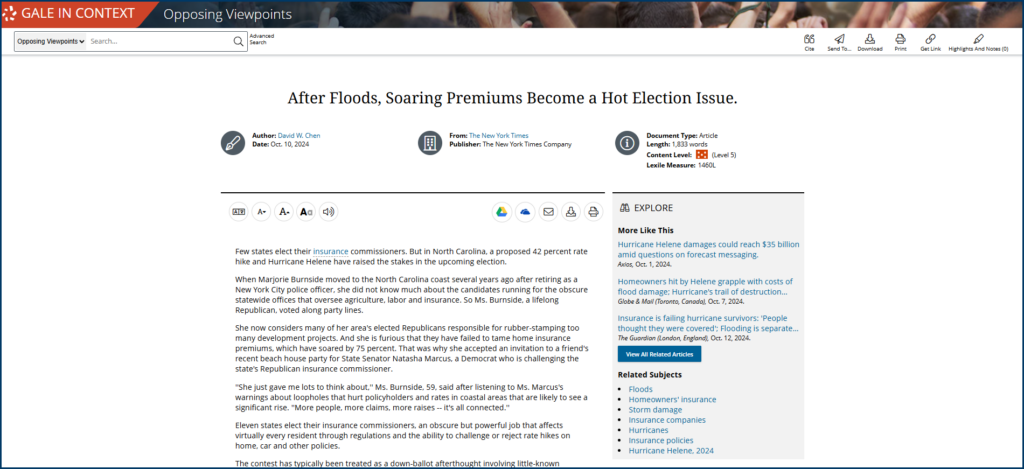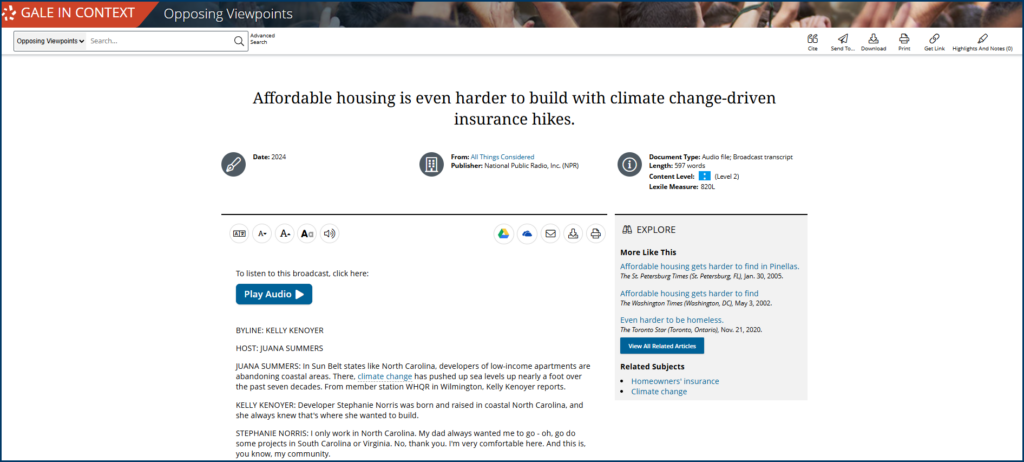Between 2015 and 2024, the United States experienced 190 separate billion-dollar disasters. Data from NOAA shows that, when adjusted for inflation, annual billion-dollar disasters averaged 3.3 events per year throughout the 1980s, but surged to 13.1 from 2010–19. So far, that number looks to be going up at an astounding rate, as the average has spiked to 23.0 between 2020 and 2024.
The growing frequency of costly natural disasters presents a challenge that today’s students will have to address as the voters and leaders of tomorrow. Prepare them to make informed choices about disaster policies and mitigation strategies by inviting them to wrestle with the economic and ethical realities of disaster response and management.
The Natural Disasters topic page, available through Gale In Context: Opposing Viewpoints, supports balanced inquiry with articles and opinion pieces from a variety of sources, such as The Washington Post, The American Conservative, and The New York Times. These editorials and news stories provide students with the latest analyses and perspectives on natural disasters, their impact on American society, and the best ways to respond.
Weighing the Future of Communities in Disaster-Prone Areas
In October 2024, Congress allocated $20 billion to the Federal Emergency Management Agency’s (FEMA) Disaster Relief Fund, allowing the organization to begin rebuilding efforts in areas affected by disaster.
Yet, just eight days into the fiscal year, nearly half of this budget was depleted. Between $7 and $8 billion went toward reimbursing expenses from earlier disasters, such as the California wildfires. The remaining funds supported emergency response and recovery efforts following two hurricanes that struck Florida just two weeks apart. The first was category 4 Hurricane Helene, the deadliest hurricane to make landfall in the U.S. since Hurricane Katrina in 2005.
While the state was still recovering from Helene’s devastation of Florida’s Big Bend region, the state’s west coast was hit by Hurricane Milton, a category 5 storm, which became the second-most intense Atlantic tropical cyclone since Hurricane Rita, also from 2005.
To reduce the long-term costs of disaster relief, some policymakers advocate for managed retreats. This strategy encourages residents in high-risk areas to relocate permanently, either through voluntary buyouts or, in some cases, government-mandated displacement.
The Case for Managed Retreats
Supporters argue that relocation is both a practical and ethical necessity. Rather than continually investing billions in disaster relief and infrastructure repair, some policymakers advocate for planned relocations that prioritize both public safety and long-term financial sustainability. Redirecting funds toward relocation, they argue, can reduce repeated disaster relief spending while offering residents greater stability and safety.
One example is the residents of Isle de Jean Charles, Louisiana—predominantly members of the Biloxi-Chitimacha-Choctaw Tribe—who have lost more than 90% of their land since 1955 due to coastal erosion and rising sea levels, exacerbated by oil and gas development.
In response to increasing coastal precarity, the federal government funded the Morganza-to-the-Gulf Hurricane Protection System to shield costal communities against storm surge. Unfortunately, the Army Corps of Engineers reported that including the island in the project would cost more than $100 million. That high price tag ultimately contributed to the decision to exclude Isle de Jean Charles from the levee system.
As an alternative, the US Department of Housing and Urban Development awarded the community $48.3 million in federal relocation assistance in 2016. Forced displacement has historically fractured Indigenous communities. In this case, however, federal funding supported efforts to relocate tribal members together, helping preserve community ties and cultural continuity.
This decision illustrates how, in some cases, limited resources make relocation more feasible than large-scale infrastructure projects designed to protect high-risk areas.
The Case Against Managed Retreats
Opponents argue that managed retreats disproportionately affect lower-income and Indigenous communities—groups with less political influence and fewer financial resources to shape their own futures. Even when relocation assistance is provided, the forced transition fractures communities, severs cultural ties, and strips residents of generational land ownership.
Isle de Jean Charles, often cited as a model for managed retreat, also reveals some of the limitations. While the Biloxi-Chitimacha-Choctaw Tribe received federal relocation funding, critics argue this funding came only after decades of neglect and repeated disasters.
Meanwhile, wealthier or strategically important regions often receive extensive disaster-mitigation funding, allowing them to avoid retreat altogether. For instance, New York City’s East Side Coastal Resiliency project is a $1.45 billion initiative designed to protect Manhattan’s waterfront from storm surges. While such large-scale projects provide long-term protection, they reinforce the notion that some communities are deemed “worth saving” while others are encouraged, or forced, to move.
Critical Thinking Questions
- Should disaster-prone communities have the right to remain in place if they accept the risks, or does the government have an obligation to intervene, even if that means overriding personal property rights?
- How do we ensure decisions about relocation are just and equitable rather than dictated by economic and political power? When relocation is deemed necessary, who should have the final say—the government, the affected communities, or a combination of both?
The Home Insurance Crisis
From 2019–24, the national average home insurance premium rose by 37.8%, outpacing the 23.45% increase in the overall inflation rate during the same period. Oklahoma now has the highest average home insurance premium in the country at $5,858 per year for a $300,000 home, while Florida’s average reached $4,231 annually in 2022—nearly triple the national average.
In some states, insurers are pulling out altogether when they deem coverage unprofitable, leaving entire communities without coverage options at any price. In Louisiana, 12 insurance providers have pulled out of the state entirely since 2020, and 50 more have stopped insuring those in hurricane-prone parishes, leaving tens of thousands of homeowners scrambling for alternatives. There are similar cases in Florida, where multiple insurers have ceased operations statewide or stopped writing new policies. In California, major insurers are scaling back coverage in wildfire-prone regions.
A Market-Driven Approach to Economically Sustainable Land Use
Forcing insurers to continue offering coverage in extreme-risk areas could backfire. If companies are forced to provide policies where the financial risk is too high, they may raise premiums for all homeowners or withdraw from entire states to avoid unsustainable losses. If regulations require an insurer to stay in-state, reduced availability may still follow, as some companies stop writing new policies or limit the areas in which they operate.
The National Flood Insurance Program (NFIP) has been held up as a model for possible alternative solutions for properties that private insurers deem uninsurable—though critics urge that the NFIP itself is in need of urgent reform.
Some argue that removing uninsurable properties from the market is a necessary correction. If certain regions are too expensive to insure, it discourages construction in disaster-prone zones and forces communities to rethink long-term development. Rising premiums, in this view, act as a financial warning system, signaling which areas are no longer economically sustainable.
Insurance pricing is one of the few market-driven tools to discourage poor land-use decisions. From this perspective, an absence of financial consequences over a period of decades enabled housing overdevelopment into coastal and wildfire-prone areas. Because insurers are now refusing to cover homes in these areas, policymakers could be forced to reconsider zoning laws.
The Case Against Allowing Insurers to Determine Presence and Pricing in High-Risk Areas
Critics argue that rising insurance costs is not only financially troubling but a barrier to homeownership itself in states like Oklahoma and Louisiana. Without insurance, homeowners may find it nearly impossible to refinance, rebuild, or purchase a new home after a disaster, as lenders typically require coverage to approve mortgages.
The problem is especially stark when comparing home insurance as a percentage of household income:
- Oklahoma homeowners pay 8.8% of the state’s median household income ($62,138) to maintain coverage. The average cost of insurance runs $5,478 annually.
- Louisiana’s burden is $3,510, 6% of median income ($58,229).
- California homeowners pay just $1,121, or 1.2%, of California’s median income ($95,521) for coverage.
While income levels are lower in Oklahoma and Louisiana compared to California, so is the overall cost of living. Yet, homeowners in these states are still paying a much larger share of their income for insurance. As a result, residents of these states are systematically priced out of homeownership.
Those who manage to hold onto their homes may be forced to forgo insurance altogether, meaning they must pay for any damage out of pocket—something many cannot afford. Others may be left with the impossible choice of selling at a loss or staying in an increasingly precarious financial situation.
Critical Thinking Questions
- How can governments balance market stability with consumer protection when insurance companies withdraw from high-risk areas?
- If homeowners in disaster-prone areas are more financially vulnerable, should taxpayer-funded relief programs subsidize their insurance costs? Why or why not?
Asking students to engage with natural disasters in the context of real-world economic and human consequences is an opportunity to broach additional conversation about the role of government and the free market.
To fuel your discussion on a range of complicated and timely topics, turn to Gale In Context: Opposing Viewpoints for access to a wealth of in-depth and balanced resources. We offer an ever-expanding collection of expertly curated materials to anchor classroom debates.
To learn more about Gale In Context: Opposing Viewpoints or our entire collection of academic databases, please reach out to your local Gale sales representative to request a free trial.




